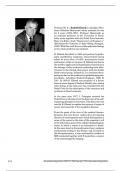Professor Dr. h.c. Rudolf Klimek is a disciple of Pro-
fessor Bolesław Skarzynski whose assistant he was
for 6 years (1952–1957). Professor Skarzynski as
an assistant professor at the University in Stock-
holm wrote together with the Nobel Prize laureate,
Hans von Euler a book “Biochemistry of Neoplasms“
(Biochemie der Tumoren, F. Enke Verlag, Stuttgart,
1942). With this work the era of the molecular biology
in the whole medicine was initiated.
R. Klimek described in 1963 post-partum hypotha-
lamic insufficiency syndrome, characterized among
others by more often (10–20%) precancerous states
and cancers of the cervix uteri. R. Klimek was first in
the world to apply natural hypothalamic hormones in
the therapy of this syndrome confirming their effec-
tiveness by the clinical observation with the double
blind-control group. (Klimek R.: Les resultats thera-
peutiques des cas du syndrome hypothalamique post-
gravidique. Actualites Endocrinologiques. 1968, 9,
195) In 1976 R. Klimek was promotor of a doctor
honoris causa degree of Andrew Schally who, among
other things, in the next year was rewarded with the
Nobel Prize for the description of the structure and
synthesis of these hormones.
In the same year, 1977, I. Prigogine received the
Nobel Prize in Chemistry for the discovery of the self-
organizing dissipative structures. This discovery was
used by R. Klimek to explain the mystery of origin of
cancer and caused by it the neoplastic diseases.
From the point of the view of the medical thermo-
dynamics this new theory unifies all so far existing
theories of cancerogenesis and clearly distinguishes a
cause of the cancer as the state of the organism’s cell
in the bifurcation point of the cellular dissipathogenic
states, in which a cancer is an alternative to death.
At the same time his thermodynamic theory explains
mechanisms leading to the disease, and as based on
the thermodynamics, it was confirmed by studies on
MRI conducted together with P. Lauterbur, a creator
of the nucleomagnetic imaging.
412 Neuroendocrinology Letters ISSN 0172–780X Copyright © 2001 Neuroendocrinology Letters
, Neuroendocrinology Letters ISSN 0172–780X
Copyright © 2001 Neuroendocrinology Letters
invited nel review
I NV I T E D
Biology of Cancer:
Thermodynamic Answers to Some Questions
Rudolf Klimek
Ob/Gyn Departments, Jagiellonian University, Cracow, Poland.
Correspondence to: Prof. dr h.c. R.Klimek, M.D., Ph.D., FRSM, FWLA,
Ob/Gyn Depts, Jagiellonian University,
31–501 Cracow, Kopernika 23, Poland.
TEL/FAX: 48 12 64213666
E-MAIL: mmklimek@cyf-kr.edu.pl
Submitted: November 27, 2001
N E L
Accepted: December 2, 2001
Key words: carcinogenesis, thermodynamic cause of cancer, dissipative
structure of cancer, cancer therapy
Neuroendocrinology Letters 2001; 22:413–416 pii: NEL220601R03 Copyright © Neuroendocrinology Letters 2001
Abstract All the theories of carcinogenesis have properly described this event from
REV IEW
methodologically different points of view (medical, biological, social, bio-
chemical psychological etc.). The point is that one should understand the
thermodynamical rules underlying each of these approaches. On this level of
knowledge, quantum thermodynamics combines matter and energy, while
technical quantization in a novel way differentiates precancerous states as
the dissipathogenic ones from the neoplasms as the newly formed dissipa-
tive structures (systems). From the essential nature of the neoplasm one
can derive some general rules of therapy which focus mainly on: 1° pre-
vention and therapy of the dissipathogenic states, 2° strengthening of the
regenerative and defensive mechanisms of the organism and, finally, 3°
removal of neoplastic changes as widely as necessary but also as sparingly
as possible. For a long time, these rules have been observed in reverse order.
That cannot improve the medical outcome, which has not changed for a few
dozen years, i.e. recovery depending on the clinical level at the moment of
the diagnosis.
413




